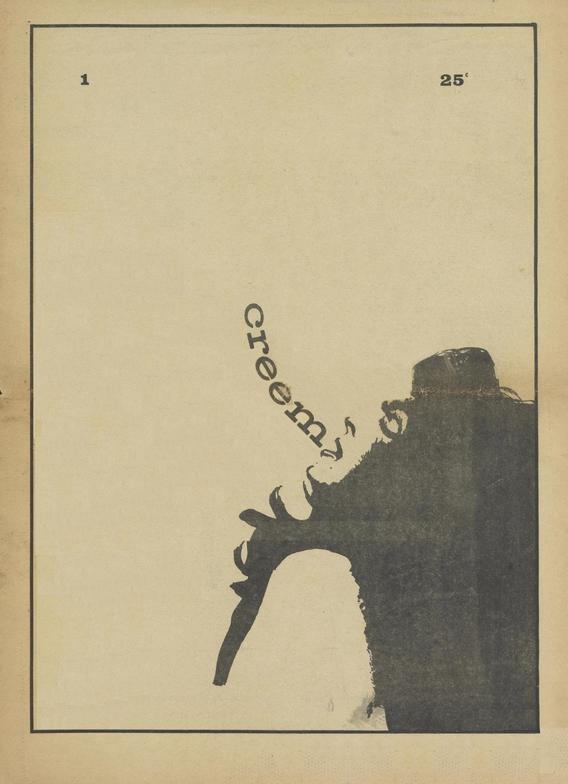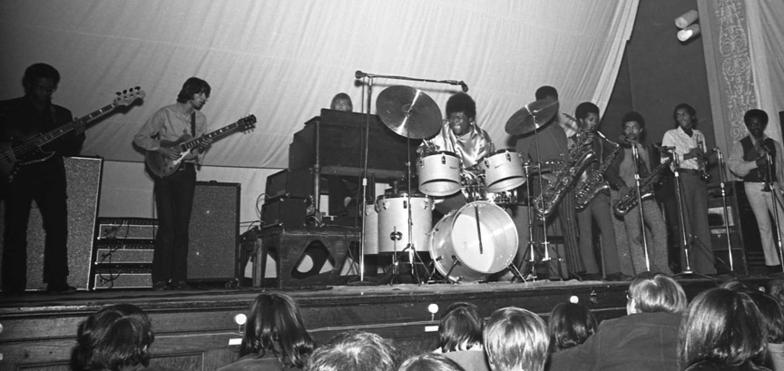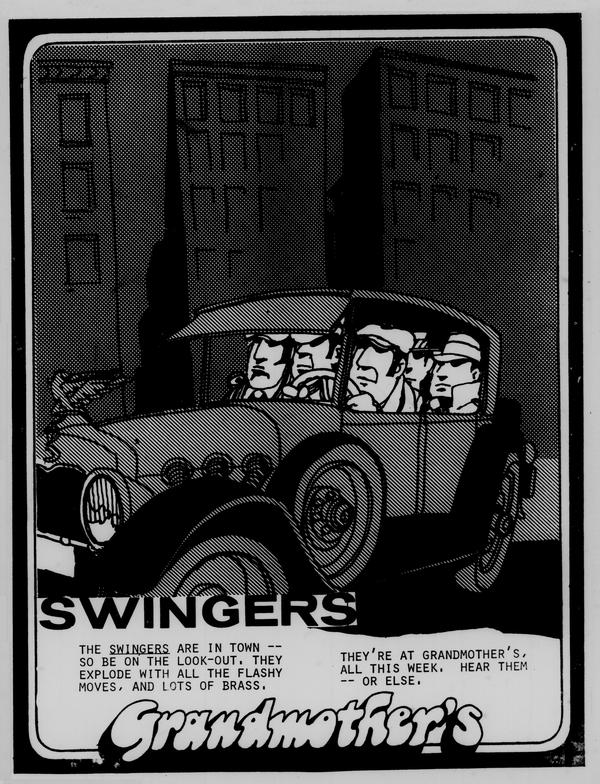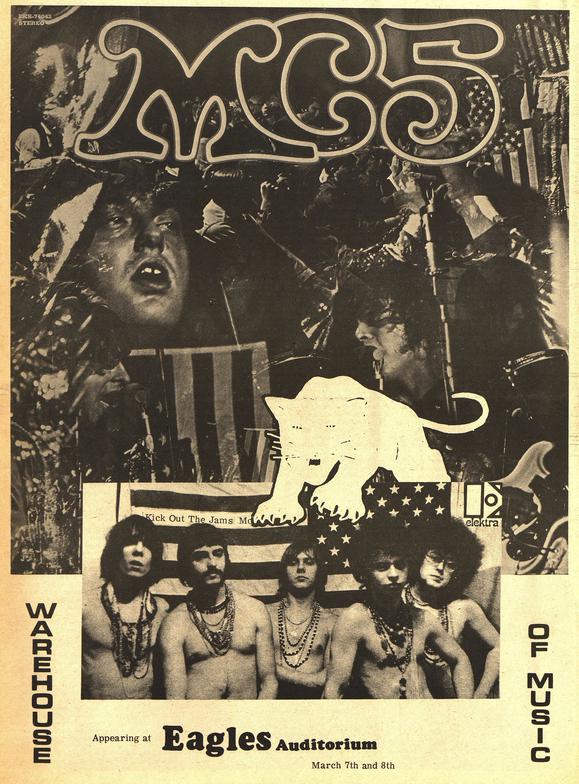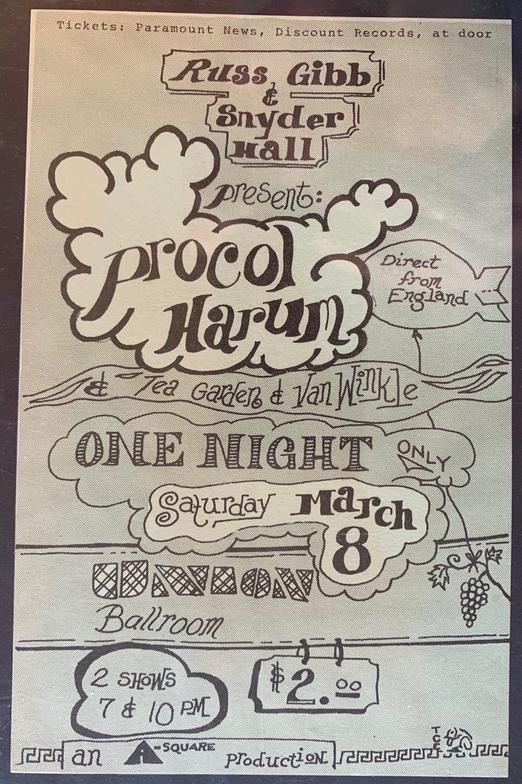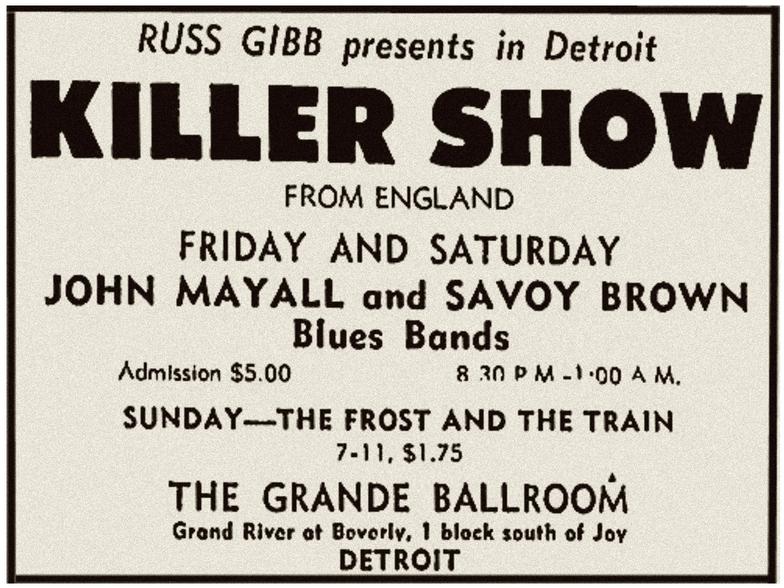Splatt Gallery
Double click here to add text.
Splatt Gallery's History of Michigan Concert Posters
Volume Five - 1969 - Page Four
Poster by an unknown artist for the Village Pub, February 29 – March 1, 1969.
The James Gang from Cleveland, Ohio, were just about to record their debut album when they played this show at the Village Pub, followed by a night at the Grande Ballroom. Both of those shows were tape-recorded by high school student, Allen Licari. In the following video, Allen provides an interesting introduction, and a decent sounding audio of The James Gang on Sunday, March 2, 1969 at the Grande Ballroom in Detroit, Michigan.
The James Gang - Bluebird (live at the Grande Ballroom) (1969)
https://www.youtube.com/watch?v=A4dg__uftnE
***********************************************************
With an Events Calendar that covered March 1-14, 1969, the first issue of CREEM magazine hit the streets. The 28-page, newspaper-format publication was jam-packed with illustrations, photos, and music, music, music. CREEM was the creation of the near-Aesthetic, Tony Reay, a British ex-pat who had arrived in Detroit via a story we hope to tell someday.
The afore-mentioned Events Calendar was second to none, in addition to every teen club, ballroom, night club, and rock show in the area (that spanned from downtown Detroit down river to Wyandotte, north to Pontiac, and west to Ann Arbor), listings included the Detroit Symphony Orchestra (with plenty of additional classical music), ballets, jazz, blues, raga, films, theater, art galleries, sports, and every other endeavor of human enlightenment and entertainment. The calendar took up the insides of both the front and back covers in small print (the entire paper was a small print font, it was really PACKED with information).
The paper actually started as an events calendar, suggested to Reay by Jeep Holland, owner of A-Squared Records in Ann Arbor, as a valuable and necessary tool to consolidate the burgeoning cultural scene for the benefit of eager consumers. In what had to be incredibly physical, manual data processing, with scraps of paper, red pens and typewriters, no computers, no spreadsheets other than hand-drawn, the events calendar was distributed around the local clubs and caught the attention of Russ Gibb, who became interested in financing an expanded version, which got Barry Kramer, the owner of the Mixed Media record store on Cass Avenue in Detroit, interested in financing an expanded version.
Issue #1 had an elegantly stark cover illustration, created by Terry Dokter, a simple beauty, ideal for a logo, and was used, in a smaller size, throughout the magazine and in future issues. The back cover was a full-page ad for Columbia Records, with the little square pictures of album covers, embellished with a large illustration by the artist LINZ.
All that we’ve discussed so far was just the outer wrapper, inside there were 24 pages that included an area map with a key to cool locations, excellent photographs that were the beginning of the illustrious career of Charlie Auringer, real tasty writing by Tony Reay, who was also a music writer at The Fifth Estate and The Detroit News, and Richard Walls, the only writer who would be with CREEM from Issue #1 to the very last issue.
At least a half-dozen drawings by LINZ, including a particularly good one of the MC5, along with art by the other three graphic artists were found on nearly every page. A dozen contributors, in addition to the staff writers (including future WDET radio program director, Judy Adams) provided stories, interviews, reviews, and gossip on a dizzying array of musical subjects, locally focused, but universally applied.
And they would do it all again in two weeks.
Portraits of the MC5 and Iggy by the artist Linz in the first issue of CREEM magazine, March 1969.
An advertisement for James Taylor’s debut album by the artist Linz in the first issue of CREEM magazine, March 1969.
An ad for the Grande Ballroom in Detroit, Michigan by CREEM magazine artist Linz, in the first issue of CREEM magazine, March 1969.
Full-page photo of Cream drummer Ginger Baker by Charlie Auringer in the debut issue of CREEM magazine in March 1969.
An assortment of art from the debut issue of CREEM magazine in March 1969, also the first staff box, showing Editor Tony Reay, contributing editor Bob Stark, photographer Charlie Auringer, calendar by Resa Janett, reviewers Judy Adams (classical) and Richard Walls (jazz), and art by Linz, Terry Dokter, The C (made the “Tyrannosaurus Rex”), and Myron Green, with General Manager Barry Kramer.
A pretty cool ad, by an unknown artist, for WABX 99.5 radio in Detroit, Michigan, “Wine, Women and WABX”, from the debut issue of CREEM magazine in March 1969.
Interesting newspaper ad for Glenn Yarbrough at Hill Auditorium in Ann Arbor, Michigan, March 1, 1969.
An ad for the Motown Revue in Indianapolis, Indiana, March 1, 1969, with a line-up of the Contours, Tammi Terrell, the Spinners, and the Fabulous Miracles Show Band. It’s very likely that Tammi Terrell may have cancelled this appearance. Her solo debut album had been released in January 1969, and the song listed on the ad, “This Old Heart of Mine”, was a single taken from the album, but according to some sources, Terrell was too ill to promote the record and she had stopped performing in early 1969.
It is also possible that this was one of her final performances. Her famously noted final public appearance was at a Marvin Gaye show at the Apollo Theater in New York City when Gaye brought her up on stage, the date of that show has been described as “late 1969”, but has also been identified as May 10, 1969, it would have been one of only very few performances by Marvin Gaye between 1968 and 1972.
Tammi Terrell - This Old Heart of Mine (1969)
https://www.youtube.com/watch?v=E_MAOpKLNSk
A full-page Elektra Records ad for the first MC5 album in the March 1, 1969 edition of The East Village Other in New York City.
Poster by Juryj (“George”) Ostroushko for the Buddy Miles Express, which included former-Detroit Wheels guitarist Jim McCarty at the Labor Temple in Minneapolis, Minnesota, March 2, 1969.
A photo of the Buddy Miles Express at the Labor Temple in Minneapolis, Minnesota, March 2, 1969, with former-Detroit Wheels guitarist Jim McCarty.
A story and photo in the March 2, 1969 edition of The State Journal newspaper in Lansing, Michigan of graphics contest winner, and future poster artist, Dennis Preston.
A neat ad for The Swingers at Grandmother’s in East Lansing, Michigan, March 3-8, 1969 that looks to be the work of Phil Frank of the State News.
Poster, or program cover, and tour itinerary for Stevie Wonder’s UK tour, which began on March 6, 1969 with a show at Top of the Pops in London, England and lasted through March 27th with at least 33 shows.
Program booklet for Stevie Wonder’s March 1969 UK tour.
A poster for Stevie Wonder’s March 1969 British Concert Tour with the bulk of the tour itinerary, March 7-23, 1969. The tour was preceded with an appearance at the Top of the Pops in London, England on March 6th. The poster lists 30 shows, two each night. Three more dates were added to the end of the tour, ending up back in London on March 27th, which may have also been two shows per night, bringing the total somewhere between 34 to 37 shows over the course of three weeks.
A poster full of hearts by an artist signed “Haig” for Diana Ross & the Supremes at Indiana State University on March 7, 1969.
James Render poster, for the Woolies with Frut of the Loom at the Village Pub in Birmingham, Michigan, March 7, 1969, and with Frijid Pink and Plain Brown Wrapper the following night.
And so, The MC5 headed out west. The band flew to Seattle, Washington to play two nights, opening for Jethro Tull at the Eagles Auditorium, March 7-8, 1969, while John Sinclair and Dennis Frawley, still at WFMU in New Jersey, but now a close enough associate to be the White Panther’s “East Coast Minister of Propaganda”, flew to San Francisco and met up with Gary Grimshaw, Minister in Exile.
The poster for this show was made by Seattle poster artist John Moehring, who produced most of the posters for The Eagles Auditorium, and also ran the Retinal Circus light show group and worked at The Helix, Seattle’s very artistic underground newspaper.
But despite the similarities with Detroit, in the psychedelic ballroom, a great underground paper and a fantastic poster artist, the audiences in Seattle “just weren’t ready for The MC5”, according to Sinclair and the band was pelted with apples.
Newspaper ad for The MC5 at Eagles Auditorium in Seattle, Washington, March 7-8, 1969.
Poster by an unknown artist for Alice Cooper at the IDES Hall in Hayward, California, March 7-8, 1969.
An ad for a Marvin Gaye show in Anaheim, California, March 7-9, 1969 with special guest star, the Ramsey Lewis Trio. Gaye had just performed with Ramsey Lewis’ ex-trio, Young-Holt, a few weeks earlier in Houston, Texas.
A newspaper ad for the 127th weekend at the Grande Ballroom, March 7-9, 1969, a mixed bag with Procol Harum, Dorian Coste, and Wilson Mower Pursuit on the first night, followed by Jeff Beck, Thomas Blood, and Caste on the second night, and Teegarden & Van Winkle with Third Power on the third night.
An events calendar in a Detroit newspaper for the 127th weekend at the Grande Ballroom, March 7-9, 1969.
Poster by James Render for the Spencer Davis Group, Forgotten Faces, and Tea at the Silverbell in Auburn Hills, Michigan, March 8, 1969. The Spencer Davis Group had performed in Lansing, Michigan earlier in the week, and at the Hideout in Clawson, Michigan the night before this show. They would also appear at the Crow’s Nest East in St. Clair Shores, Michigan the next night after this show, making for a mini-Michigan tour for the British group.
Two poster/flyers, both by an unknown artist, signed TCE, for Procol Harum with Teegarden (sic) & Van Winkle at the Union Ballroom in Ann Arbor, Michigan on March 8, 1969. Both, an A-Square Production (Jeep Holland) and a Russ Gibb production.
An ad for “the Parliaments featuring the Funkadelics” plus the Irresistibles and the DeVilles at Oakland University in Rochester, Michigan on March 8, 1969.
Poster for Stevie Wonder in Croydon, England on March 9, 1969, the fourth show of his 19-show UK tour.
An artist living at the Trans-Love commune in Ann Arbor, named Al Shamie, signed his work as “Bad Dog”, contributed to The Ann Arbor Argus, and created this poster for the March 10, 1969 launch of a series of Tuesday concerts by The Up at the Canterbury House.
The Moon was a swanky club in Hazel Park, Michigan that reeked of beef wellington and cigars. The Tokyo Happy Cats were five sisters from Japan that had nearly a ten-year happiness butchering the pop songs of the day. A perfect match.
Ad for The Seventh Ann Arbor Film Festival, March 11-16, 1969.
Two different color versions of a poster by an unknown artist (Gordon?) for Alice Cooper at the White Room in Buena Vista, California, March 14, 1969.
A newspaper ad for a “Killer Show” on the 128th weekend at the Grande Ballroom, March 14-16, 1969, with John Mayall and Savoy Brown performing the first two nights, along with Third Power both nights, with Wicked Religion on the first night, and Phenomenon on the second night. Frost and Train appeared on the Sunday night, March 16th.
An events calendar in a Detroit newspaper for the 128th weekend at the Grande Ballroom, March 14-16, 1969, plus two shows by the San Francisco, California group Moby Grape at the teen clubs Hideout and Silverbell.
Turning their backs on an unreceptive Seattle, Washington, John Sinclair took the band back to San Francisco, where he quickly discovered that Bill Graham’s black-listing of The MC5 because of the earlier trouble at the Fillmore East in New York City, was firm and resolute and had spread around town.
The Family Dog, with all of the Detroit friends, had stopped promoting shows at the Avalon Ballroom at the end of 1968 due to Graham’s direct competition, and had moved on to Denver, Colorado. The new promoters for the Avalon had also been convinced by Graham not to hire The MC5, so with a limited choice of willing venues, Sinclair booked the band for a three-night run at the Straight Theater.
A local band, Clover, opened the shows, a decade later they would be the band on Elvis Costello’s first album, and later still, the band would evolve into Huey Lewis & the News.
Gary Grimshaw came up with one of his best-known posters for these shows on March 14-16, 1969.
The MC5 – Starship (1969)
https://www.youtube.com/watch?v=6uyNCg5D-Ow
Full-page newspaper ads for the MC5 at the Straight Theater in San Francisco, California, March 14-16, 1969.
A nice glossy color poster for the MC5 at the Straight Theater in San Francisco, California, March 14-16, 1969.
Poster by James Render, for a three-night stand by Teegarden & Van Winkle at the Something Different club in Southfield, Michigan, March 14-16, 1969.
Over the weekend that the MC5 were playing at the Straight Theater in San Francisco, March 14-16, 1969, the University of Detroit held its 20th Annual Spring Carnival at the Michigan State Fairgrounds, promoted by Mike Quatro with a poster by Carl Lundgren, featuring the Bob Seger System, Rotary Connection, Red White & Blues Band and Poor Richard’s Almanac.
Since we’ve seen the band from Chicago, Rotary Connection, on a half-dozen posters so far, including the Grande Ballroom, and they will show up again, at least ten more appearances in Detroit in 1969 alone, let’s talk about them.
The band was assembled by Marshall Chess, the son of Chess Records founder Leonard. When the father put his son in charge of a start-up label, Cadet Concept Records, Marshall joined session musicians from the Chess stable, including guitarist Phil Upchurch, with a local band, The Proper Strangers, and added a Chess receptionist named Minnie Ripperton.
Purposely experimental, the ensemble performed and recorded cover versions of popular songs of the times, drastically re-arranging them, often with long orchestral and choral into build-ups. “Purposely experimental” usually translates into “fail”, and we find many of these songs to be unlistenable, also the case with their original compositions, but they were a very popular live act, as we can see from their frequent shows throughout Michigan, and there’s no denying the their talent.
After seven albums, including a 1968 record of Christmas music entitled “Peace”, their most successful LP, the group went their separate ways, most notably Minnie Ripperton in her solo career, and Marshall Chess, himself, who became the founding president of Rolling Stones Records, and more pertinently to our story later, recorded the Detroit band, Black Merda.
Here is Rotary Connection’s version of the Cream song, “Tales of Brave Ulysses”, which works better than most of the others, as perhaps it sticks closer to the original and is less “purposely” arranged.
Rotary Connection – Tales of Brave Ulysses (1969)
https://www.youtube.com/watch?v=yPNmq-OuSpc
SRC and Frut of the Loom at Schoolcraft College in Livonia, Michigan, March 14, 1969, promoted by Mike Quatro with a poster by Carl Lundgren.
A very nice full-page Roulette Records ad in the March 15, 1969 issue of Billboard magazine for the single “Sweet Cherry Wine” by Tommy James & the Shondells.
Volume Five - 1969 - continues - HERE
A Grande Ballroom ad by Dave Baker in the Ann Arbor Argus newspaper for 128th weekend, March 14-16, 1969, with an interesting note at the bottom, “Watch for Grande Head Comix” that is a missing link of sorts to the upcoming “Tales from the Ozone” comic book which was being partially financed by Russ Gibb.
We toyed around with how “Grande Head Comix” may have looked, which also demonstrates that “Tales from the Ozone” was probably the superior result. In addition, “Head Comix” wasn’t exactly original, as R. Crumb had already used the title for his 1968 comic book.



